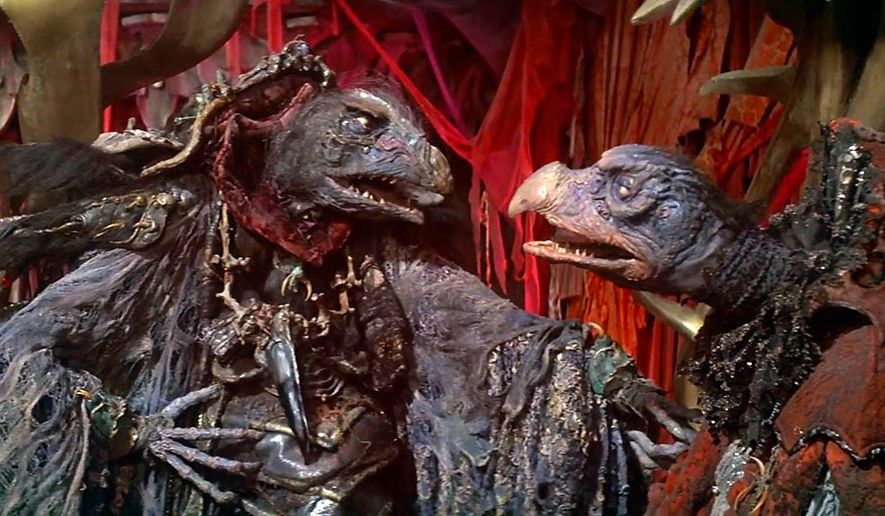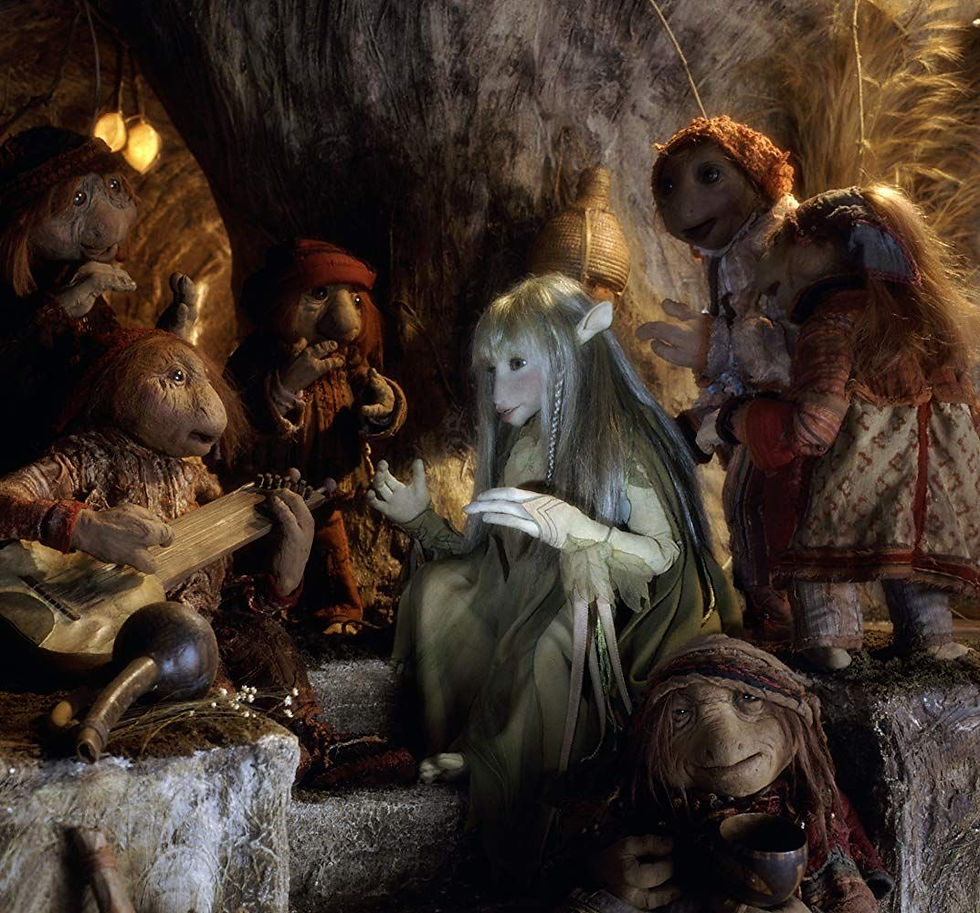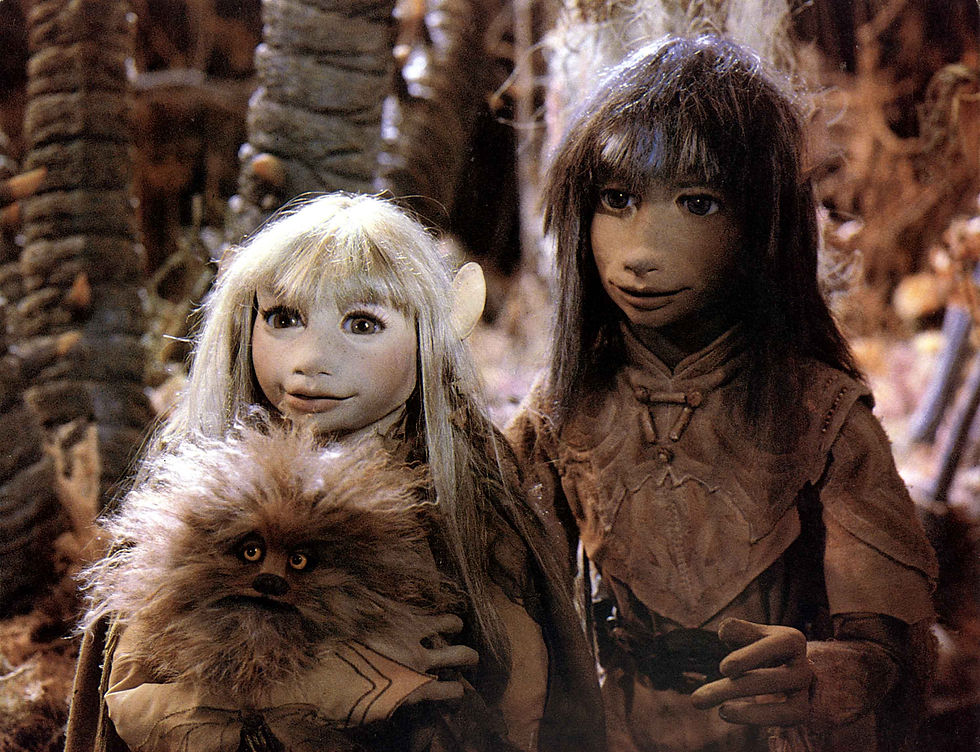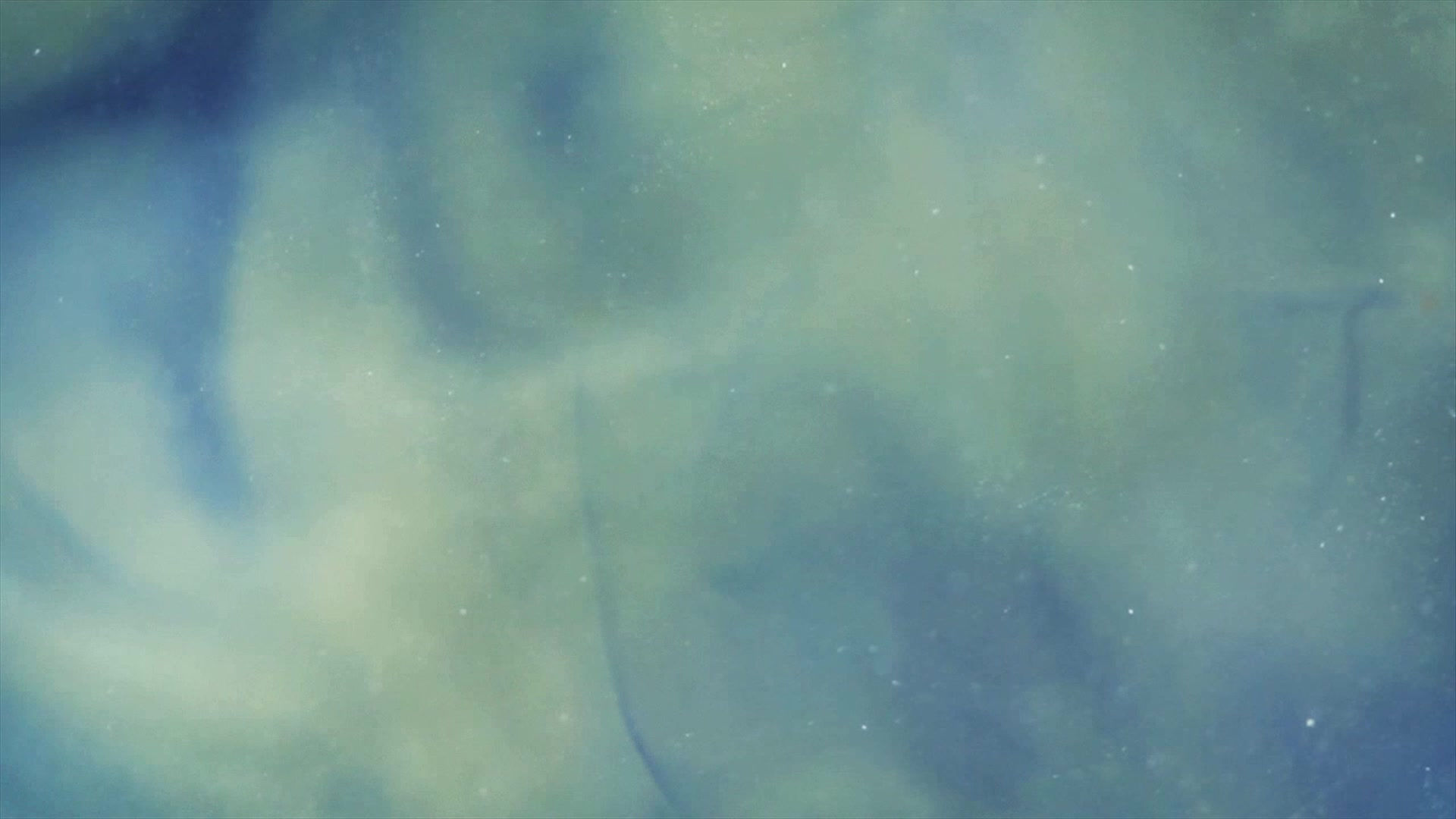Psycho's Movie Reviews #76: The Dark Crystal (1982)
- Nov 26, 2021
- 14 min read

The Dark Crystal is a 1982 dark fantasy film directed by Jim Henson and Frank Oz. It stars the voices of Stephen Garlick, Lisa Maxwell, Billie Whitelaw, Percy Edwards, and Barry Dennen. The film was produced by ITC Entertainment and The Jim Henson Company and distributed by Universal Pictures. The plot revolves around Jen, a Gelfling on a quest to restore balance to the world of Thra and overthrow the ruling Skeksis by restoring a powerful broken Crystal.
It was marketed as a family film, but was notably darker than the creators' previous material. The animatronics used in the film were considered groundbreaking for its time, with most creatures, like the Gelflings, requiring around four puppeteers to achieve full manipulation. The primary concept artist was fantasy illustrator Brian Froud, famous for his distinctive fairy and dwarf designs. Froud also collaborated with Henson for his next project, the 1986 film Labyrinth.
The Dark Crystal was produced by Gary Kurtz, while the screenplay was written by David Odell, with whom Henson previously worked as a staff writer for The Muppet Show. The film score was composed by Trevor Jones. The film initially received mixed reviews from mainstream critics; while being criticized for its darker, more dramatic tone in contrast to Henson's previous works, it was praised for its narrative, aesthetic, and characters. Over the years, it has been re-evaluated by critics and has garnered a cult following.
A prequel television series, The Dark Crystal: Age of Resistance, premiered on Netflix in 2019.
Plot:
A thousand years ago on the planet Thra, two new races appeared when a Shard was shattered from the Crystal of Truth: the cruel Skeksis, who use continued corruption of the Crystal to extend their lives, and the gentle urRu, more commonly known as Mystics, who make their home in the Valley of Stones to await their destiny. The leader of the Mystics, the Master UrSu, raises a young Gelfling named Jen whose clan were slaughtered by the Skeksis. As the Great Conjunction of Thra's three suns draws near, a dying UrSu instructs Jen to fulfil a prophecy to heal the Crystal by first retrieving the Shard from Aughra. As UrSu passes, the Skeksis' Emperor, skekSo, also dies, leaving the position for the leader vacant. The Chamberlain, skekSil, and the Garthim Master, skekUng, challenge each other in a "Trial by Stone" for succession, resulting in skekUng defeating skekSil. SkekSil is stripped of his robes and banished, while skekUng is proclaimed the new emperor. When the Skeksis learn of Jen's existence, they send their army of giant crab-like Garthim to capture him, with the cunning skekSil following.
Jen meets Aughra and enters her orrery, which she uses to predict the heavens, and she explains about the Conjunction before having Jen select the correct Shard. Before Aughra can explain Jen's mission, the Garthim arrive and destroy the orrery, taking Aughra prisoner as Jen flees. Hearing the call of the Crystal, the Mystics leave their valley to return to the Castle of the Crystal. On his journey through a forest swamp, Jen meets Kira, another surviving Gelfling. The two learn more about each other when they accidentally "dreamfast", sharing each other's memories. They stay for a night with the Podlings who raised Kira, only for them and Kira's pet Fizzgig to flee when the Garthim raid the village. They are nearly caught, but skekSil intervenes, keeping the Garthim from pursuing them.
Jen and Kira discover a ruined Gelfling civilization with ancient writing describing the prophecy: "When single shines the triple sun, what was sundered and undone shall be whole, the two made one by Gelfling hand or else by none." They are interrupted by skekSil, who reveals the prophecy was the reason for the Gelfling genocide while trying to trick them into coming with him to the castle. But the Gelflings run off and reach the castle on Landstriders, intercepting the Garthim that attacked Kira's village. While trying to free the captured Podlings, Kira, Jen, and Fizzgig descend to the Castle's dry moat (revealing Kira has wings) and use the catacombs to gain access. But they are intercepted by skekSil, who attempts to drag them to the other Skeksis when they refuse him further. Jen stabs skekSil's hand with the Shard in defiance (which leads to his Mystic counterpart, urSol, to receive a similar wound on his), and skekSil, in a fit of rage, buries Jen in a cave-in and takes Kira. SkekSil is reinstated as Chamberlain and gives Kira to the Scientist, skekTek, to be drained of her life essence for the Skeksis to drink and regain their youth. Aughra, imprisoned in the Scientist's laboratory, tells Kira to call the captive animals for help; they break free in response and free Kira while causing skekTek to fall down the crystal shaft to his death. At that moment, his Mystic counterpart, urTih, vanishes in a burst of flame. Aughra frees herself soon after Kira leaves and before Jen arrives.
The three suns begin to align as the Gelflings reunite at the Crystal Chamber and the Skeksis gather for the ritual that will grant them immortality. When they are discovered and the Garthim attack, Jen leaps onto the Crystal but drops the Shard. Kira takes it after Fizzgig is thrown down the shaft by skekUng, but is saved by Aughra shortly after. Kira throws the Shard back to Jen and is fatally stabbed by the Ritual-Master, skekZok. The heartbroken Jen plunges the Shard into the Dark Crystal, fulfilling the prophecy. The Garthim disintegrate and the Podling slaves regain their essence while the dark stone covering the Castle crumbles away to reveal a crystalline structure. The urRu arrive and use the Crystal to merge themselves and the Skeksis into the beings they once were: the angelic urSkeks. The urSkeks' leader explains to Jen they had mistakenly shattered the Crystal 1,000 years ago, splitting them into two races and decimating Thra, and that Jen's courage and Kira's sacrifice have restored them. The urSkeks revive Kira in gratitude and then ascend to a higher level of existence, leaving the Crystal of Truth to Jen and Kira on the now-rejuvenated Thra.

Production
Development:
Henson's inspiration for the visual aspects of the film came around 1975–76, after he saw an illustration by Leonard B. Lubin in a 1975 edition of Lewis Carroll’s poetry showing crocodiles living in a palace and wearing elaborate robes and jewellery. The film's conceptual roots lay in Henson's short-lived The Land of Gorch, which also took place in an alien world with no human characters. According to co-director Frank Oz, Henson's intention was to "get back to the darkness of the original Grimms' Fairy Tales", as he believed that it was unhealthy for children to never be afraid.
Henson formulated his ideas into a 25-page story he entitled The Crystal, which he wrote whilst snowed in at an airport hotel. Henson's original concept was set in a world called Mithra, a wooded land with talking mountains, walking boulders and animal-plant hybrids. The original plot involved a malevolent race called the Reptus group, which took power in a coup against the peaceful Eunaze, led by Malcolm the Wise. The last survivor of the Eunaze was Malcolm's son Brian, who was adopted by the Bada, Mithra's mystical wizards.
This draft contained elements in the final product, including the three races, the two funerals, the quest, a female secondary character, the Crystal, and the reunification of the two races during the Great Conjunction. "Mithra" was later abbreviated to "Thra", due to similarities the original name had with an ancient Persian deity.[8] The character Kira was also at that point called Dee.
Most of the philosophical undertones of the film were inspired from Jane Roberts's "Seth Material". Henson kept multiple copies of the book Seth Speaks, and insisted that Froud and screenwriter David Odell read it prior to collaborating for the film. Odell later wrote that Aughra's line "He could be anywhere then," upon being told by Jen that his Master was dead, could not have been written without having first read Roberts' material.
The Bada were renamed "Ooo-urrrs", which Henson would pronounce "very slowly and with a deep resonant voice." Odell simplified the spelling to urRu, though they were ultimately named Mystics in the theatrical cut. The word "Skeksis" was initially meant to be the plural, with "Skesis" being singular, though this was dropped early in the filming process. Originally, Henson wanted the Skeksis to speak their own constructed language, with the dialogue subtitled in English.
Accounts differ as to who constructed the language, and on what it was based. Gary Kurtz stated that the Skeksis language was conceived by author Alan Garner, who based it on Ancient Egyptian, while Odell stated it was he who created it, and that it was formed from Indo-European roots. This idea was dropped after test screening audiences found the captions too distracting, but the original effect can be observed in selected scenes on the various DVD releases. The language of the Podlings was based on Serbo-Croatian, with Kurtz noting that audience members fluent in Polish, Russian and other Slavic languages could understand individual words, but not whole sentences.
The film was shot at Elstree Studios from April–September 1981, and exterior scenes were shot in the Scottish Highlands; Gordale Scar, North Yorkshire, England; and Twycross, Leicestershire, England. Once filming was completed, the film's release was delayed after Lew Grade sold ITC Entertainment to Robert Holmes à Court, who was sceptical of the film's potential, due to the bad reactions at the preview and the need to re-voice the film's soundtrack. The film was afforded minimal advertisement and release until Henson bought it from Holmes à Court and funded its release with his own money.

Design:
Brian Froud was chosen as concept artist after Henson saw one of his paintings in the book Once upon a time. The characters in the film are elaborate puppets, and none are based on humans or any other specific Earth creature. Before its release, The Dark Crystal was billed as the first live-action film without any human beings on screen, and "a showcase for cutting-edge animatronics".
The hands and facial features of the groundbreaking animatronic puppets in the film were controlled with relatively primitive rods and cables, although radio control later took over many of the subtler movements. Human performers inside the puppets supplied basic movement for the larger creatures, which in some cases was dangerous or exhausting; for example, the Garthim costumes were so heavy that the performers had to be hung up on a rack every few minutes to rest while still inside the costumes. Swiss mime Jean-Pierre Amiel was hired to help choreograph the movements of the puppeteers. Amiel also performed the Weaver Mystic.
When conceptualizing the Skeksis, Henson had in mind the seven deadly sins, though because there were 10 Skeksis, some sins had to be invented or used twice. Froud originally designed them to resemble deep sea fish, but later designed them as "part reptile, part predatory bird, part dragon", with an emphasis on giving them a "penetrating stare." Each Skeksis was conceived as having a different "job" or function, thus each puppet was draped in multicoloured robes meant to reflect their personalities and thought processes.
Each Skeksis suit required a main performer, whose arm would be extended over his or her head in order to operate the creature's facial movements, while the other arm operated its left hand. Another performer would operate the Skeksis' right arm. A team of four technicians operated the Skeksis' hand and face animatronics. The Skeksis performers compensated for their lack of vision by having a monitor tied to their chests. The Chamberlain Skeksis, in particular, was built with 21 electronic components.
In designing the Mystics, Froud portrayed them as being more connected to the natural world than their Skeksis counterparts. Henson intended to convey the idea that they were purged of all materialistic urges, yet were incapable of acting in the real world. Froud also incorporated geometric symbolism throughout the film in order to hint at the implied unity of the two races. The Mystics were the hardest creatures to perform, as the actors had to walk on their haunches with their right arm extended forward, with the full weight of the head on it. Henson stated that he could hold a position in a Mystic costume for only 5–10 seconds.
The Gelflings were designed and sculpted by Wendy Midener. They were difficult to perform, as they were meant to be the most human creatures in the film, and thus their movements, particularly their gait, had to be as realistic as possible. During scenes when the Gelflings' legs were off-camera, the performers walked on their knees in order to make the character's movements more lifelike. According to Odell, the character Jen was Henson's way of projecting himself into the film. Jen was originally meant to be blue, in homage to the Hindu deity Rama, but this idea was scrapped early on.
Aughra was originally envisioned as a "busy, curious little creature" called Habeetabat, though the name was rejected by Froud, who found the name too similar to Habitat, a retailer he despised. The character was re-envisioned as a seer or prophetess, and renamed Aughra. In selecting a voice actor for Aughra, Henson was inspired by Zero Mostel's performance as a "kind of insane bird trying to overcome Tourettes syndrome" on Watership Down. Although the character was originally voiced by Oz, Henson wanted a female voice, and subsequently selected Billie Whitelaw.
The character Fizzgig was invented by Oz, who wanted a character who served the same function as the Muppet poodle Foo-Foo, feeling that, like Miss Piggy, the character Kira needed an outlet for her caring, nurturing side. The character's design was meant to convey the idea of a "boyfriend-repellent", to contrast the popular idea that it is easier to form a bond with a member of the opposite sex with the assistance of a cute dog.
The Podlings were envisioned as people in complete harmony with their natural surroundings, thus Froud based their design on that of potatoes. Their village was modelled on the Henson family home.
In designing the Garthim, Froud took inspiration from the discarded carapaces of his and Henson's lobster dinners. The Garthim were first designed three years into the making of the film, and were made largely of fiberglass. Each costume weighed around 70 lbs (32 kg), thus Garthim performers still in costume had to frequently be suspended on racks in order to recuperate.
The Dark Crystal was the last film in which cinematographer Oswald Morris, BSC, involved himself in before retiring. He shot all the footage with a "light flex", a unit placed in front of the camera which gave a faint colour tint to each scene in order to give the film a more fairy tale atmosphere similar to Froud's original paintings
Music:
The film's soundtrack was composed by Trevor Jones, who became involved before shooting had started. Jones initially wanted to compose a score which reflected the settings' oddness by using acoustical instruments, electronics and building structures. This was scrapped in favour of an orchestral score performed by the London Symphony Orchestra once Gary Kurtz became involved, as it was felt that an unusual score would alienate audiences. The main theme of the film is a composite of the Skeksis' and Mystics' themes. Jones wrote the baby Landstrider theme in honour of his newly born daughter.

Cancelled Sequel:
During the development phase of The Dark Crystal, director Jim Henson and writer David Odell discussed ideas for a possible sequel. Almost 25 years later, Odell and his wife Annette Duffy pieced together what Odell could recall from these discussions to draft a script for The Power of the Dark Crystal. Genndy Tartakovsky was initially hired in January 2006 to direct and produce the film through The Orphanage animation studios in California.
However, faced with considerable delays, the Jim Henson Company announced a number of significant changes in a May 2010 press release: It was going to partner with Australia-based Omnilab Media to produce the sequel, screenwriter Craig Pearce had reworked Odell and Duffy's script, and directing team Michael and Peter Spierig were replacing Tartakovsky. In addition, the film would be released in stereoscopic 3D.
During a panel held at the Museum of the Moving Image on September 18, 2011, to commemorate the legacy of Jim Henson, his daughter Cheryl revealed that the project was yet again on hiatus. By February 2012 Omnilab Media and the Spierig brothers had parted ways with the Henson Company due to budgetary concerns; production on the film has been suspended indefinitely. In May 2014, Lisa Henson confirmed that the film was still in development, but it is not yet in pre-production.
Ultimately, plans for a feature film were scrapped, and the unproduced screenplay was adapted into a 12-issue comic book series The Power of the Dark Crystal from Archaia Comics and BOOM! Studios, released in 2017.
Prequel Series:
In May 2017, it was announced that The Jim Henson Company in association with Netflix would produce a prequel series titled The Dark Crystal: Age of Resistance. Shooting began in the fall of 2017 with Louis Leterrier as director. The prequel was written by Jeffrey Addiss, Will Matthews, and Javier Grillo-Marxuach. The series premiered on August 30, 2019. There are ten episodes, and the series explores the world created for the original film.
Prequel Novels:
On July 1, 2013, an announcement was made by The Jim Henson Company, in association with Grosset and Dunlap (a publishing division of Penguin Group USA) that they would be hosting a Dark Crystal Author Quest contest to write a new Dark Crystal novel, as a prequel to the original film. It would be set in the Dark Crystal world during a Gelfling Gathering. The winning author was J.M. (Joseph) Lee of Minneapolis, Minnesota, whose story, "The Ring of Dreams," was selected from almost 500 contest submissions.
The novel series consists of four books: Shadows of the Dark Crystal, released on June 28, 2016; Song of the Dark Crystal, released July 18, 2017; Tides of the Dark Crystal, released December 24, 2018; and Flames of the Dark Crystal, released on August 27, 2019. Together, the novels serve to establish the setting of the Netflix series The Dark Crystal: Age of Resistance, focusing on adventures of some of the series' side characters.
Novelization:
A tie-in novelization of the film was written by A. C. H. Smith. Henson took a keen interest in the novelization, as he considered it a legitimate part of the film's world rather than just an advertisement. He originally asked Alan Garner to write it, but Garner declined on account of prior engagements. Henson and Smith met several times over meals to discuss the progress of the manuscript. According to Smith, their only major disagreement had arisen over his dislike of the Podlings, which he considered "boring". He included a scene in which a Garthim carrying a sacksful of Podlings fell down a cliff and crushed them. Henson considered this scene to be an element of "gratuitous cruelty" that did not fit well into the scope of the story. In order to assist Smith in his visualizing the world of The Dark Crystal, Henson invited him to visit Elstree Studios during filming. In June 2014, Archaia Entertainment reprinted the novelization, with included extras such as some of Brian Froud's illustrations and Jim Henson's notes.

My Review:
Ok, where do I begin? The Dark Crystal (1982) is amazing! It’s been, and always will be, one of my all-time favourite movies – and I watch a lot of movies, so that’s saying something. Everything about is remarkable. The way that there’s no human insight and all just some new fantastical world full of extraordinary creatures, puppets made by the king of puppetry himself Jim Henson. As well as handmade sets of the world’s beautiful and mysterious scenery. So much work went into making this film… and it shows. What I love the most about it is how this is a major step back from Henson’s previous puppetry creations: the light-heartedness of ‘The Muppets’, ‘Sesame Street’ and ‘Fraggle Rock’. To summarise the plot; The Dark Crystal is about a Gelfling called Jen, raised by the noble race called the Mystics, has been told that he is the last survivor of his own race, the Gelflings. He sets out to try to find a shard of the dark crystal, a powerful gem that once provided balance to the universe. After the crystal was broken, the evil Skeksis used sinister means to gain control. Jen believes that he can repair the dark crystal and bring peace back to the world, if he can only find the remaining shard. It has a much darker tone, yet it has captivated many audiences for 39 years. That and it has scared quite a few people in their younger years, few who do look back on it have admitted that the movie scared them as kids. Personally, I never – I loved, and still do, like these types of ‘Creepy Kids Films’ – but I do see how kids can find this particularly frightening, especially when it comes down to some of the character designs.
Not too long ago, I watched the behind the scenes on YouTube that showed how the puppets and sets were made, how they filmed it and how they animated the puppets. Seeing all the work that went it into the film really paid off. I would say that this film is Henson’s pinnacle of his puppet mastery. Everything, from the many unique identities of the calm Mystics to the twisted bodies of the cruel Skeksis, all the magnificent creatures really do feel like their real. With help from the great storyline and lovable characters it’s easy to get hooked on this film. Especially since it’s premier, The Dark Crystal has a major fanbase; it’s been given a popular book series and Netflix has recently partnered up with Jim Henson’s company and made a series based on the events that lead up to the film – which is just as amazing. The soundtrack is gorgeous, yet very sinister when it comes to the primary antagonists of the film, which fits perfectly with the overall atmosphere of the film. In many a ways it severely helps make the film. Trevor Jones (the composer) did an outstanding job.
Comparing it to it’s predecessors and some Henson’s future films: Labyrinth and Muppets Treasure Island, for example {Total sidenote: these 3 films are my top 3 favourite of Henson’s – the best 3 (Labyrinth being my all time favourite film, but that’s another story)}. The Dark Crystal is a movie masterpiece, one of the best family films ever made; 99/10.



Comments